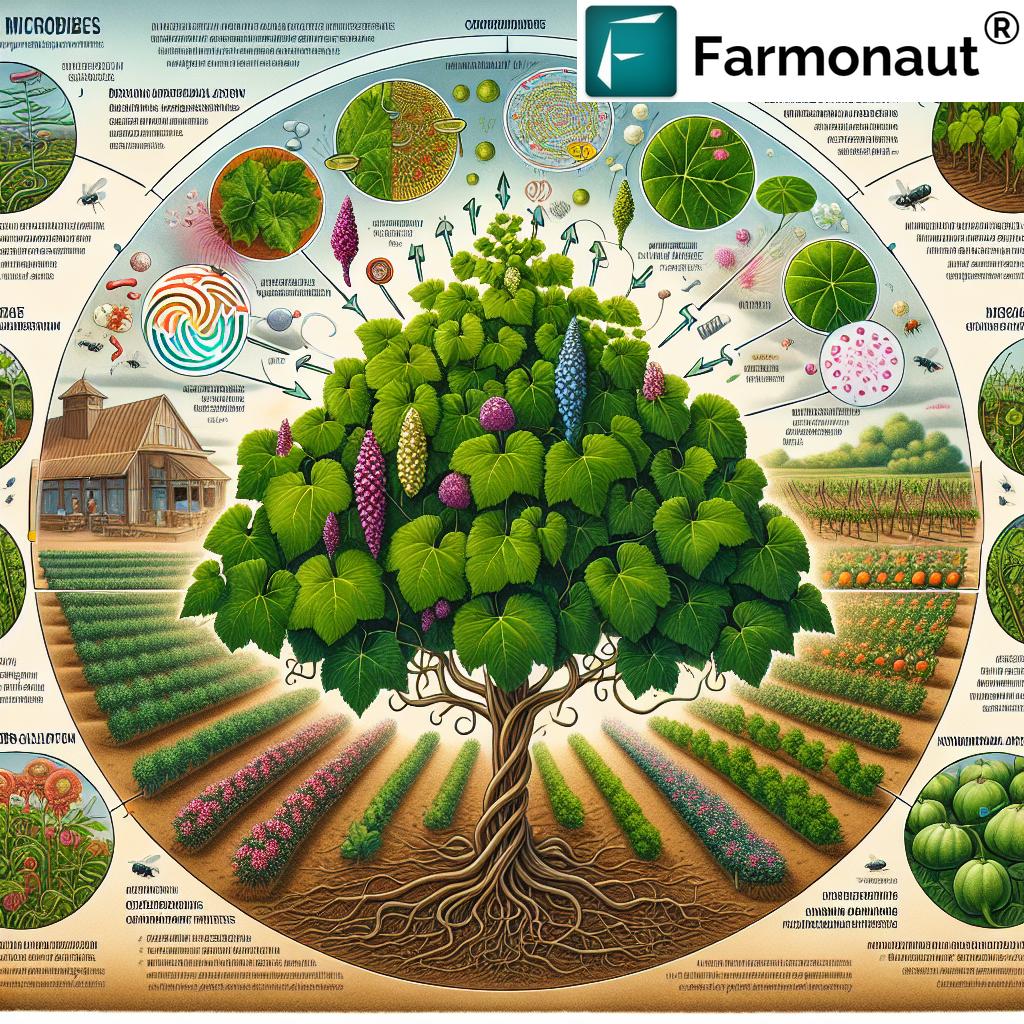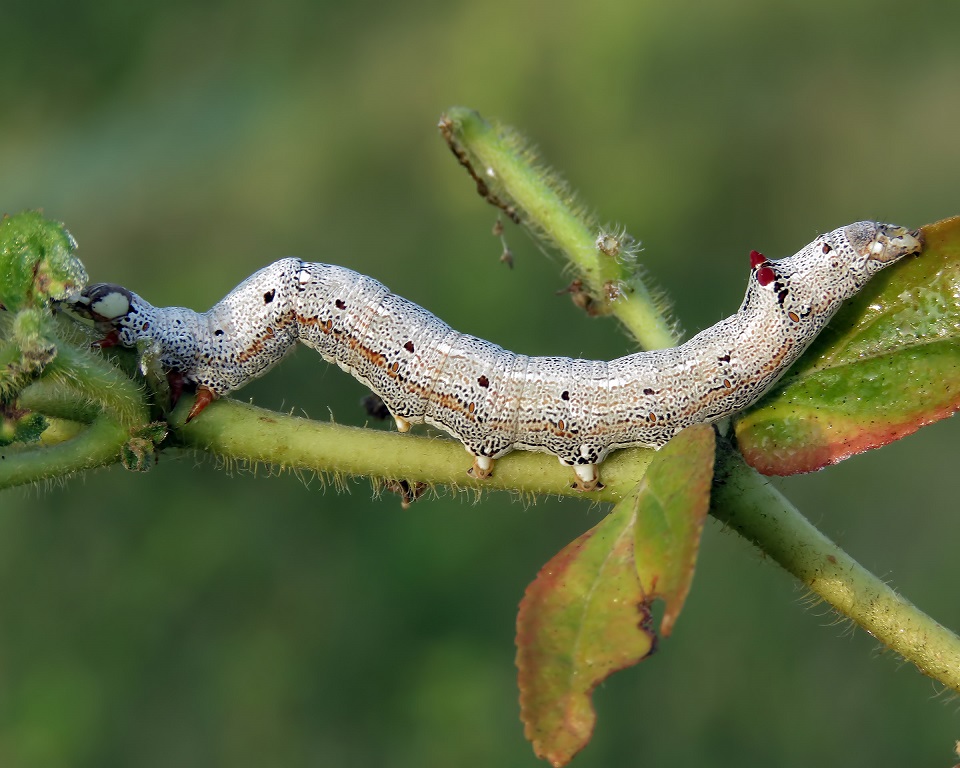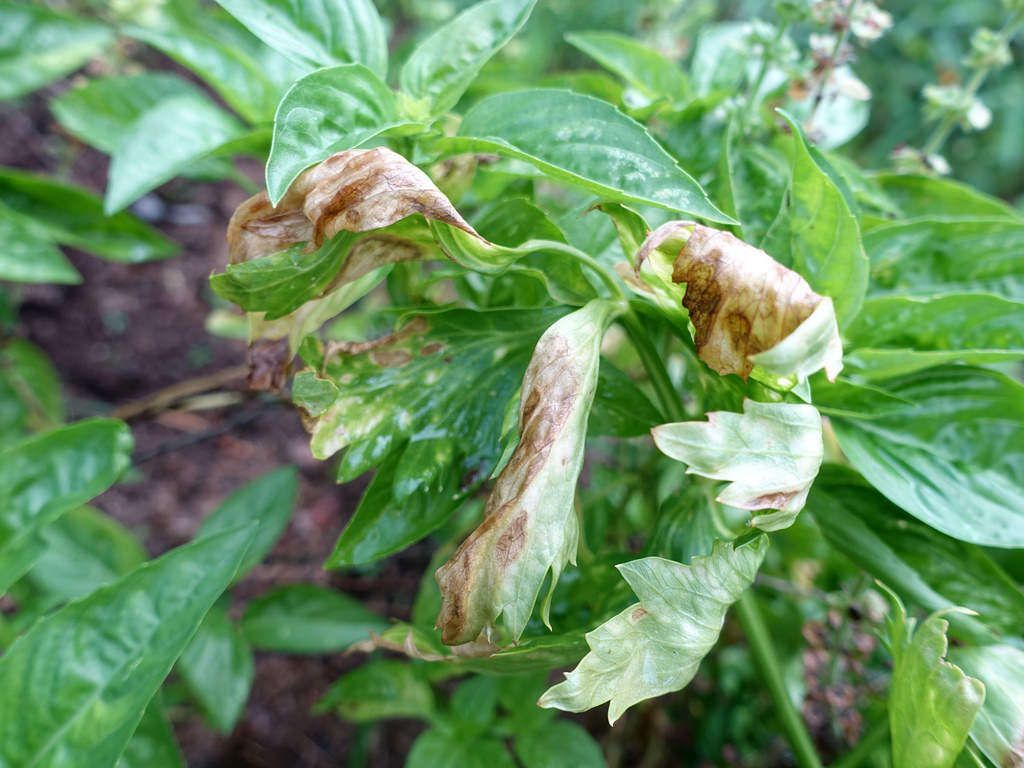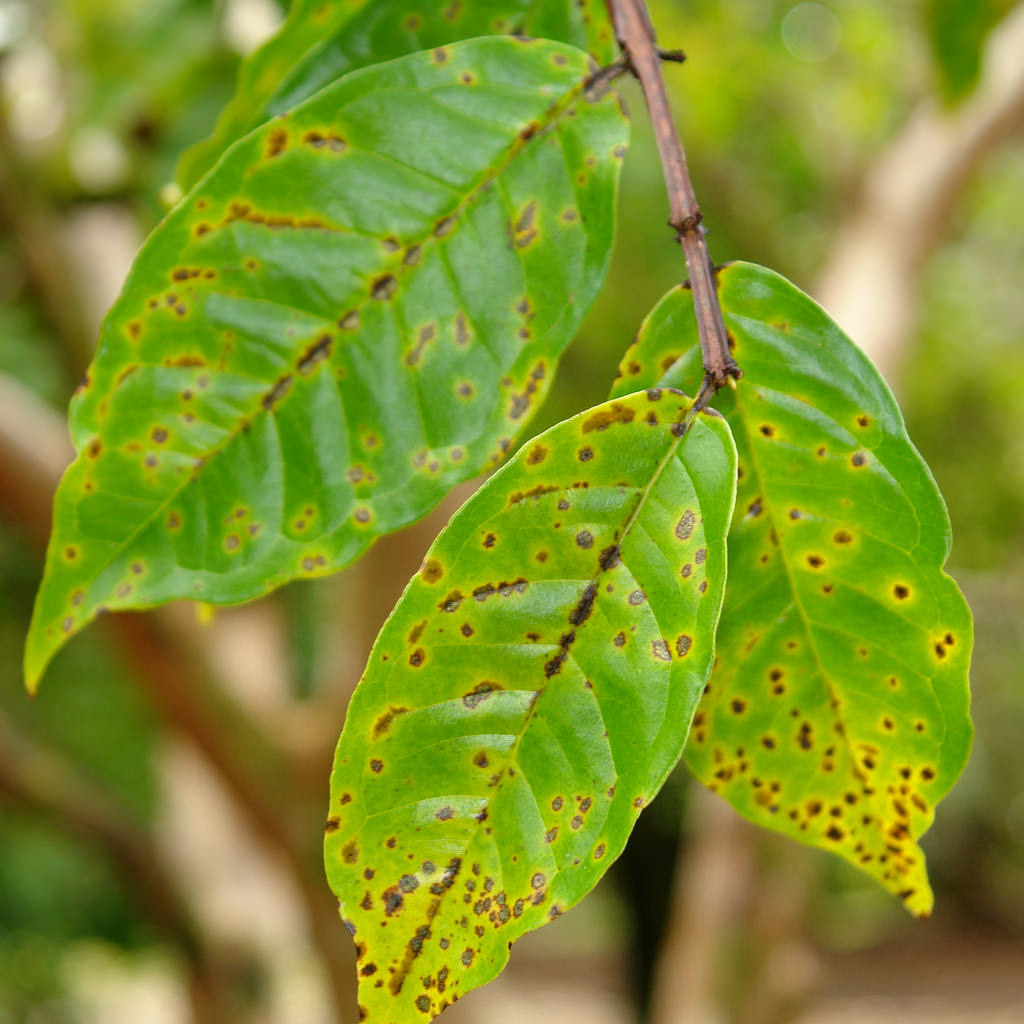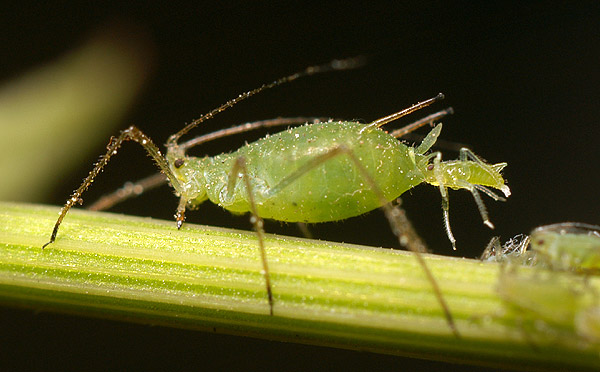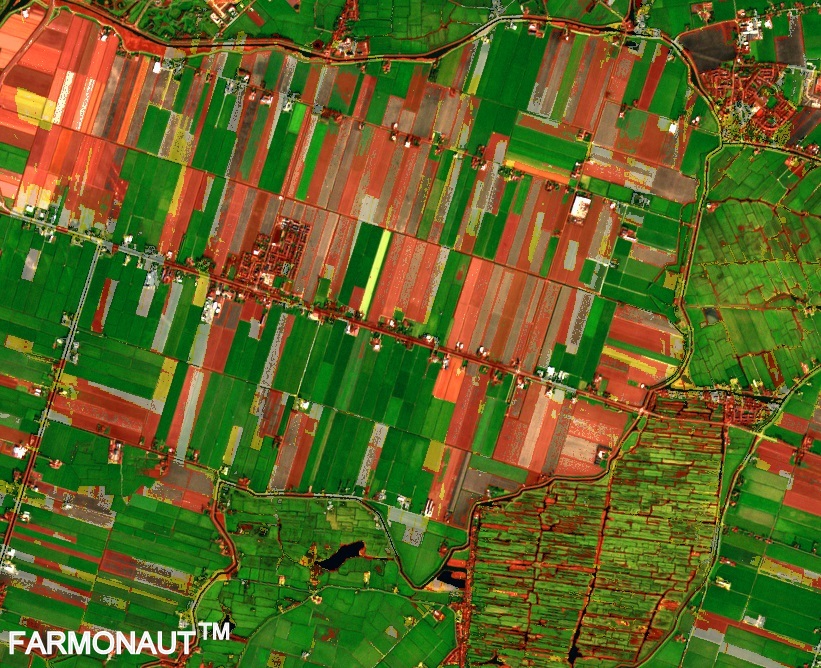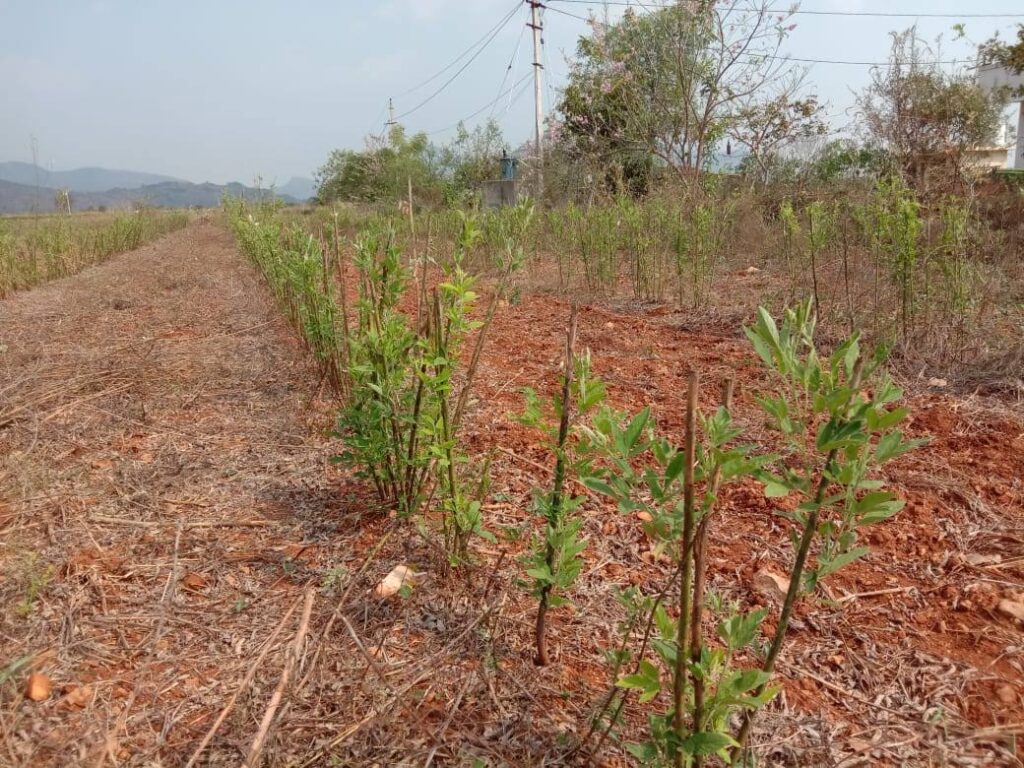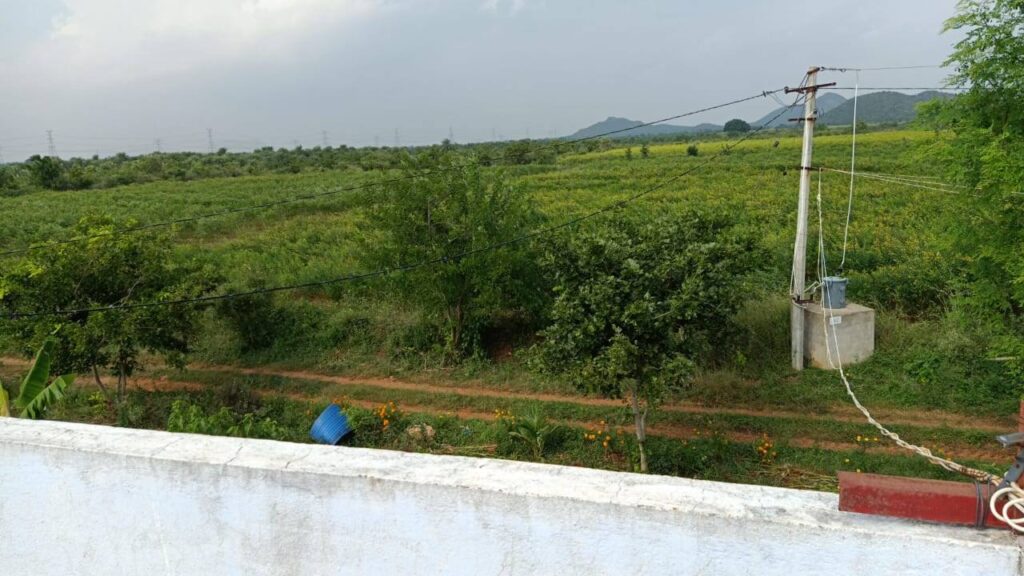Mastering Downy Mildew Management: A Comprehensive Guide to Organic Crop Protection and Sustainable Agriculture Practices
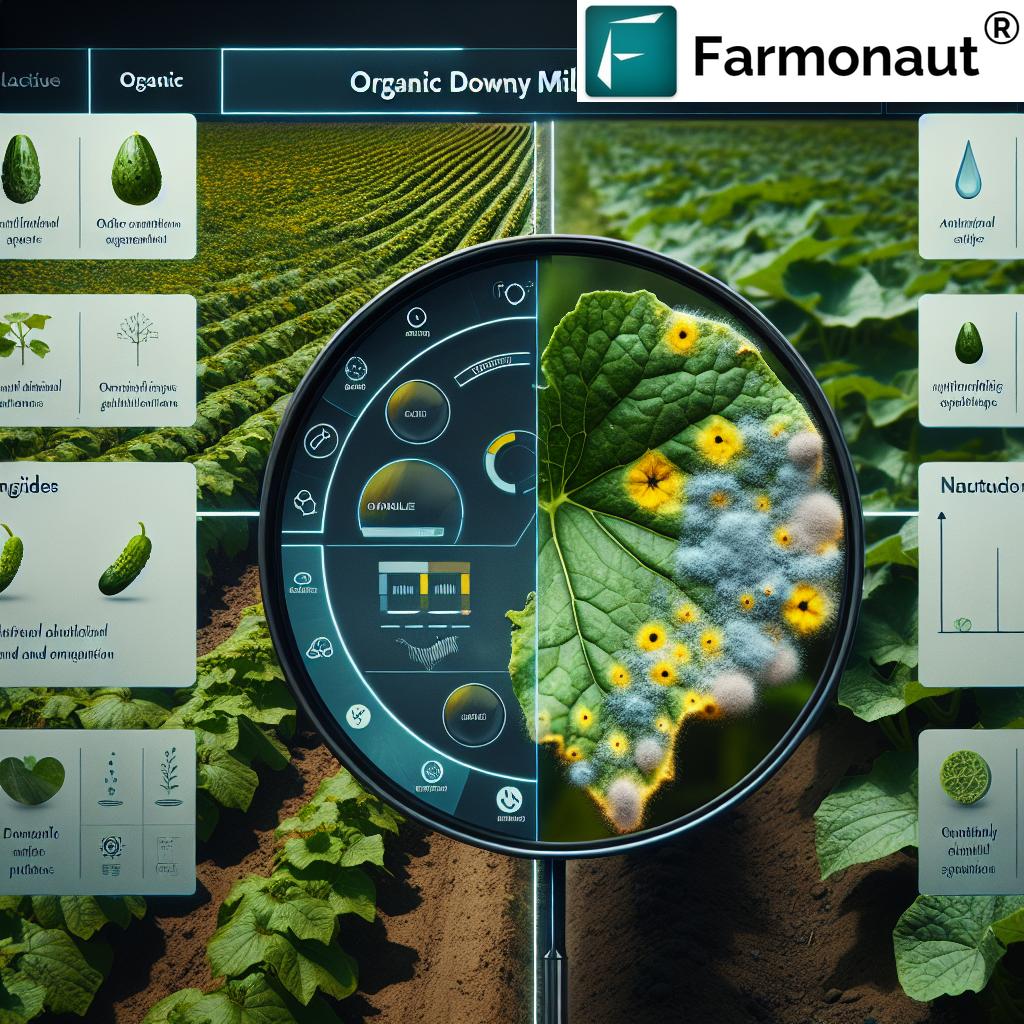
Welcome to our comprehensive guide on mastering downy mildew management through organic crop protection and sustainable agriculture practices. In this blog post, we’ll explore effective strategies to combat this persistent plant pathogen that affects a wide range of crops, from cucurbits to grapevines. Our goal is to equip you with the knowledge and tools necessary to protect your yields while promoting soil health and environmental sustainability.
“Downy mildew can affect over 50 plant species, including cucurbits, herbs, and ornamentals, making it a widespread agricultural threat.”
At Farmonaut, we understand the challenges farmers face in managing crop diseases. That’s why we’ve developed advanced satellite-based farm management solutions to support your efforts in downy mildew control and overall crop health monitoring. Our technology integrates seamlessly with the strategies we’ll discuss, providing you with real-time insights to make informed decisions.
Understanding Downy Mildew: The Stealthy Plant Pathogen
Downy mildew is a fungal-like disease caused by various species of oomycete pathogens, including Peronospora, Plasmopara, Bremia, Pseudoperonospora, and Hyaloperonospora. These pathogens thrive in cool, moist conditions and can quickly spread through crops, causing significant damage if left unchecked.
- Host Range: Downy mildew affects a diverse array of plants, including:
- Cucurbits (cucumber, squash, melon, pumpkin, zucchini, watermelon)
- Herbs (sage, parsley, coriander, dill, basil)
- Other crops (sunflower, grapevines, onion, brassicas, cabbage, cauliflower, pea)
- Ornamentals (roses, daisies, lettuce)
- Symptoms: Look for yellow or pale green spots on the upper leaf surface, with a fuzzy, grayish-white growth on the underside of leaves.
- Conditions: Favors high humidity, cool temperatures, and poor air circulation.
Understanding the nature of downy mildew is crucial for developing effective management strategies. Let’s dive into the various approaches you can take to protect your crops.
Integrated Pest Management: A Holistic Approach
Integrated Pest Management (IPM) is a sustainable approach that combines various control methods to manage pests and diseases effectively. For downy mildew, this means integrating cultural practices, chemical treatments, and organic solutions to create a comprehensive management plan.
Cultural Practices for Prevention
Implementing proper cultural practices is the first line of defense against downy mildew. These methods focus on creating an environment that’s less favorable for pathogen development:
- Improve Air Circulation: Proper plant spacing and pruning to enhance airflow, reducing humidity around plants.
- Water Management: Use drip irrigation or water early in the day to allow foliage to dry quickly.
- Crop Rotation: Rotate susceptible crops with non-host plants to break the disease cycle.
- Sanitation: Remove and destroy infected plant material to reduce inoculum levels.
- Resistant Varieties: Choose plant varieties with known resistance to downy mildew when available.
By incorporating these practices into your farming routine, you can significantly reduce the risk of downy mildew infections and create a healthier growing environment for your crops.
Chemical Treatments: A Targeted Approach
While we advocate for organic and sustainable practices, there are situations where chemical treatments may be necessary, especially in severe outbreaks. When using fungicides, it’s crucial to do so responsibly to prevent fungicide resistance and minimize environmental impact:
- Preventative Fungicides: Apply before disease onset or at the first signs of infection.
- Systemic Fungicides: These products move through the plant, offering protection to new growth.
- Contact Fungicides: Provide a protective barrier on plant surfaces.
- Rotation of Active Ingredients: Alternate between different modes of action to prevent resistance development.
Remember, always follow label instructions and local regulations when applying any chemical treatments. Farmonaut’s crop monitoring technology can help you time your applications more effectively, potentially reducing the overall use of fungicides.
Organic Solutions for Sustainable Control
For those committed to organic farming or looking to reduce chemical inputs, several effective organic solutions can help manage downy mildew:
- Copper-Based Sprays: A traditional organic fungicide, effective when used preventatively.
- Biological Control Agents: Beneficial microorganisms that can compete with or inhibit pathogen growth.
- Plant Extracts: Natural compounds like neem oil or garlic extract can have fungicidal properties.
- Compost Teas: Rich in beneficial microorganisms, can boost plant immunity and suppress pathogens.
- Silicon Supplements: Can strengthen plant cell walls, increasing resistance to fungal penetration.
These organic treatments align well with sustainable agriculture practices and can be integrated into your overall downy mildew management strategy.
Crop-Specific Strategies for Downy Mildew Management
Different crops may require tailored approaches to downy mildew management. Let’s explore strategies for some commonly affected crop groups:
Cucurbits (Cucumber, Squash, Melon)
- Use resistant varieties when available, particularly for cucumber.
- Implement wide row spacing to improve air circulation.
- Apply preventative fungicides at the first sign of disease in the area.
- Consider using plastic mulch to reduce soil moisture splash.
Grapevines
- Prune and train vines to maximize sunlight exposure and air movement.
- Use forecasting models to time fungicide applications effectively.
- Apply copper-based sprays early in the season for organic control.
- Remove leaves around fruit clusters to reduce humidity.
Herbs and Leafy Greens
- Maintain proper plant spacing to avoid overcrowding.
- Use drip irrigation to keep foliage dry.
- Harvest outer leaves regularly to improve air circulation.
- Consider using protected cultivation methods like high tunnels.
By tailoring your approach to the specific needs of each crop, you can maximize the effectiveness of your downy mildew management efforts.
Leveraging Technology for Precision Disease Management
In today’s digital age, technology plays a crucial role in effective crop management. Farmonaut’s satellite-based monitoring systems offer several advantages in the fight against downy mildew:
- Early Detection: Our advanced imagery can detect subtle changes in crop health before visible symptoms appear.
- Targeted Treatment: Precise mapping allows for focused application of control measures, reducing overall pesticide use.
- Weather Integration: Real-time weather data helps predict disease pressure and optimal treatment timing.
- Data-Driven Decisions: Historical and current crop data enable more informed management choices.
By integrating these technological solutions with traditional management practices, farmers can create a more robust and efficient downy mildew control strategy.
Explore Farmonaut’s API for advanced data integration
“Implementing integrated pest management strategies can reduce fungicide use by up to 30% while maintaining effective downy mildew control.”
Sustainable Practices for Long-Term Disease Management
While managing downy mildew is crucial, it’s equally important to focus on long-term sustainability in your farming practices. Here are some strategies that not only help with disease control but also promote overall soil and plant health:
- Cover Cropping: Plant cover crops during off-seasons to improve soil structure and reduce erosion.
- Composting: Incorporate high-quality compost to enhance soil microbial activity and plant resilience.
- Biodiversity: Encourage beneficial insects and microorganisms by maintaining diverse plant species on your farm.
- Conservation Tillage: Minimize soil disturbance to preserve soil structure and beneficial organisms.
- Water Conservation: Implement efficient irrigation systems to reduce water waste and minimize favorable conditions for pathogens.
These practices contribute to a healthier farm ecosystem, making your crops naturally more resistant to diseases like downy mildew.
Monitoring and Evaluation: The Key to Continuous Improvement
Effective downy mildew management requires ongoing monitoring and evaluation of your strategies. Here’s how you can stay on top of your crop health:
- Regular Scouting: Inspect your crops frequently, especially during high-risk periods.
- Record Keeping: Maintain detailed records of disease occurrence, treatments applied, and their effectiveness.
- Weather Monitoring: Use local weather data to anticipate disease pressure.
- Soil Testing: Conduct regular soil tests to ensure optimal plant nutrition and soil health.
- Technology Integration: Utilize Farmonaut’s satellite monitoring to track crop health trends over time.
By consistently evaluating your management practices, you can refine your approach and improve your success in controlling downy mildew year after year.
Comparison of Downy Mildew Management Strategies
| Crop Type | Cultural Practices | Chemical Treatments | Organic Solutions | Monitoring Methods | Prevention Tips | Estimated Effectiveness |
|---|---|---|---|---|---|---|
| Cucurbits | Improve air circulation, Proper spacing | Systemic fungicides, 7-10 day intervals | Copper-based sprays, Biological control agents | Visual inspection, Sensor technology | Resistant varieties, Crop rotation | High |
| Grapes | Canopy management, Leaf removal | Preventative fungicides, Based on forecasting | Potassium bicarbonate, Compost teas | Disease forecasting models, Visual scouting | Proper pruning, Site selection | Medium to High |
| Herbs | Drip irrigation, Greenhouse cultivation | Limited use, Only when necessary | Neem oil, Garlic extract sprays | Regular visual inspection | Avoid overhead watering, Proper spacing | Medium |
| Brassicas | Crop rotation, Raised beds | Fungicides with different modes of action | Silicon supplements, Beneficial microbes | Leaf wetness sensors, Visual checks | Resistant cultivars, Proper nutrition | Medium to High |
| Ornamentals | Proper spacing, Good ventilation | Systemic and contact fungicides | Milk sprays, Herbal extracts | Regular scouting, Humidity monitoring | Sanitation, Resistant varieties | Medium |
This table provides a quick reference for managing downy mildew across different crop types. Remember that the effectiveness of each strategy can vary based on local conditions, severity of the outbreak, and timely implementation.
The Role of Nutrition in Disease Resistance
Proper plant nutrition plays a crucial role in enhancing natural disease resistance. Well-nourished plants are better equipped to withstand pathogen attacks and recover from infections. Here are some key nutrients that can boost your crops’ resilience against downy mildew:
- Potassium: Strengthens cell walls and improves overall plant health.
- Silicon: Enhances physical barriers against pathogen entry.
- Calcium: Crucial for cell wall structure and plant defense mechanisms.
- Zinc: Important for enzyme production and overall plant metabolism.
- Manganese: Plays a role in photosynthesis and disease resistance.
Implementing a balanced fertilization program based on soil tests and crop requirements can significantly contribute to your downy mildew management strategy.
Access Farmonaut’s API Developer Docs for advanced integration
Embracing Biodiversity for Natural Pest Control
Encouraging biodiversity on your farm can create a natural defense system against pests and diseases, including downy mildew. Here’s how you can promote biodiversity:
- Intercropping: Plant compatible crops together to disrupt pest cycles and promote beneficial interactions.
- Hedgerows and Flower Strips: Establish areas of diverse plant species to attract beneficial insects and natural predators.
- Crop Rotation: Rotate crops from different families to break disease cycles and improve soil health.
- Cover Cropping: Use diverse cover crop mixes to enhance soil biology and suppress pathogens.
- Beneficial Insects: Introduce or encourage populations of ladybugs, lacewings, and other beneficial insects.
By creating a more diverse ecosystem on your farm, you’re building a resilient environment that’s naturally more resistant to disease outbreaks.
The Future of Downy Mildew Management
As we look to the future, several emerging technologies and practices show promise in enhancing our ability to manage downy mildew effectively:
- Gene Editing: Developing more resistant plant varieties through precise genetic modifications.
- AI-Powered Prediction Models: Advanced algorithms that can predict disease outbreaks with greater accuracy.
- Nanotechnology: Nano-formulations of fungicides for improved efficacy and reduced environmental impact.
- Drone Technology: Precision application of treatments and high-resolution crop monitoring.
- Microbiome Engineering: Enhancing plant-associated microbial communities for natural disease suppression.
While these technologies are still evolving, they represent exciting possibilities for more effective and sustainable downy mildew management in the years to come.
Conclusion: A Holistic Approach to Downy Mildew Management
Mastering downy mildew management requires a comprehensive, integrated approach that combines cultural practices, judicious use of treatments, and cutting-edge technology. By implementing the strategies outlined in this guide, you can significantly reduce the impact of downy mildew on your crops while promoting sustainable agriculture practices.
Remember, successful management is an ongoing process that requires vigilance, adaptability, and a commitment to continuous improvement. With tools like Farmonaut’s satellite-based monitoring system at your disposal, you’re well-equipped to tackle the challenges posed by downy mildew and other crop diseases.
We encourage you to explore our range of services designed to support your farming efforts and enhance your crop management strategies.
Frequently Asked Questions (FAQ)
- What are the first signs of downy mildew infection?
Early symptoms include yellow or pale green spots on the upper leaf surface, often accompanied by a fuzzy, grayish-white growth on the underside of leaves. - Can downy mildew be cured once it infects a plant?
While it’s challenging to cure an infected plant completely, prompt action with appropriate fungicides or organic treatments can help control the spread and minimize damage. - How often should I apply fungicides to prevent downy mildew?
The frequency depends on the product used and disease pressure. Generally, preventative applications every 7-14 days during high-risk periods are recommended. Always follow label instructions. - Are there any natural predators of downy mildew?
While there are no direct predators of downy mildew, certain beneficial microorganisms can compete with or inhibit its growth. Promoting a healthy soil ecosystem can support these beneficial organisms. - How can Farmonaut’s technology help in managing downy mildew?
Farmonaut’s satellite-based monitoring system can detect early signs of crop stress, potentially indicating disease onset. This allows for timely interventions and more targeted management strategies.
